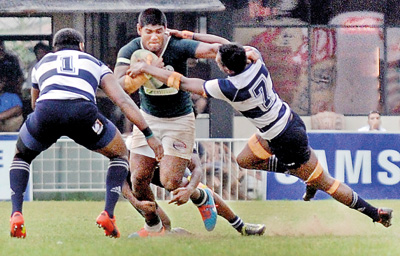A slight knock-on and a hard tackle
View(s): I heard this phrase “it was a slight knock-on” being used on a number of times during games. Does the law identify the difference of a knock on and a slight knock on or is the referee supposed to do that? By saying so does one expect the referee to allow such mistakes and call it letting the game flow? If he does again you nail him. Suddenly I heard this same words being said over a broadcast and wondered whether it is from here — in Europe, the phrase was picked up. It is interesting to think on how you perceive what the referee should do.
I heard this phrase “it was a slight knock-on” being used on a number of times during games. Does the law identify the difference of a knock on and a slight knock on or is the referee supposed to do that? By saying so does one expect the referee to allow such mistakes and call it letting the game flow? If he does again you nail him. Suddenly I heard this same words being said over a broadcast and wondered whether it is from here — in Europe, the phrase was picked up. It is interesting to think on how you perceive what the referee should do.
 Another point that is being discussed is about the yards gained by Omalka Gunaratne and how to stop him. The advice given and was to go low and repeat an often quoted old adage “bigger the man the harder the fall”. I heard this number of times and asked myself if it is that easy why somebody is not doing it. On the other hand will it be prudent to try and stop a human dynamo taking him head on and low risking the chance of getting his knee on your head. The physics involved in a good tackle is to upset the centre of gravity. Hit the weakest part of the body which happens to be around the centre of gravity and around the waist. Using the passive tackle, taking the man low, is to use the body weight and the momentum of the tackled player. The aggressive tackling as we see more today is to push the player in another direction such as in side on tackles. Stopping Omalka is not about “bigger the man harder the fall. “ Stop him taking off and stop him having good ball.
Another point that is being discussed is about the yards gained by Omalka Gunaratne and how to stop him. The advice given and was to go low and repeat an often quoted old adage “bigger the man the harder the fall”. I heard this number of times and asked myself if it is that easy why somebody is not doing it. On the other hand will it be prudent to try and stop a human dynamo taking him head on and low risking the chance of getting his knee on your head. The physics involved in a good tackle is to upset the centre of gravity. Hit the weakest part of the body which happens to be around the centre of gravity and around the waist. Using the passive tackle, taking the man low, is to use the body weight and the momentum of the tackled player. The aggressive tackling as we see more today is to push the player in another direction such as in side on tackles. Stopping Omalka is not about “bigger the man harder the fall. “ Stop him taking off and stop him having good ball.
The tackle is an area that is often penalized and lot of shouting is heard. Is this a result of not knowing the law or the eagerness to get good ball and or hang on to the ball. I am more prone to accept the latter as today most coaches and players are aware of the need to get quick ball at the tackle. On the field it is momentarily being mad thinking that you are doing a service.
To get the nuts and bolts of a tackle the first thing is to make sure that there is no contact above the shoulders as this is dangerous: you will definitely get a penalty or even a serious dismissal. We often hear comments about being marginal and or that the tackle was below first or the player bent down or was short. The fact is the most important and not the intention. It is all about the tackle being safe.
Equally dangerous is the tendency to go low and below the knee with shoulders only and no hands around. If a tackle above the shoulder is dangerous and the tip tackle is dangerous, what do you call this? It happens often and should not be encouraged.In a tackle the player in possession of the ball has give it up as soon as he reaches the ground, usually by passing it to a team-mate or putting it on the ground. To do that it is important for the tackler to release the tackled player. The release by the tackler is getting better but the roll away needs improvement as we see a tendency to sleep where you are. So both the player who is tackled and the one who is tackling must roll away immediately after the tackle. The first however is for the tackler to release the tackled player. Similarly the tackled player too must release and roll away.
The arriving players who have to stay on their feet and they also have to be careful not to enter from the sides. It is only if you are on your feet and arrive properly that you can pick up the ball. A team mate of the player who is tackled can pick up the ball immediately after the tackle provided they are still standing on their feet and or a ruck has not formed. If the ball is still on the ground, and players bind over the ball the tackle becomes what is known as a ruck nobody is allowed to handle the ball. If a maul forms, where players are in contact in accordance with the law and the ball is held whilst all are still standing, a tackle is not allowed for safety reasons.
Tackler release, tackled player releases the ball, arriving players enter properly and stay on your feet and the tackle is done. What about the entry of the tackler and the tackled player which are different to code for the arriving players. That is when the laws become more complicated that what you think. Stick to the basics in the tackle law and you will play better rugby and or enjoy the game more.


